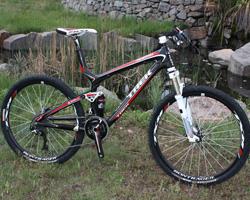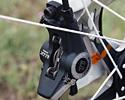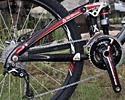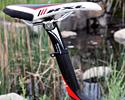
Recently on Cyclingnews.com |
On test: Trek Top Fuel 9.9 SSL, May 29, 2009
Cross-country rocket ship

|
Trek's impressive mountain bike lineup overhaul continues with their latest Top Fuel 9.9 SSL cross-country full-suspension flagship. Cyclingnews technical editor James Huang heads out on both an early prototype and later a full-blown production model and finds something oh-so-close to perfection.
Trek's Top Fuel 9.9 SSL flagship hits the target of what a premium-level cross-country race bike should be squarely in its center yet it's also capable of more with a few component tweaks and in the hands of a skilled rider.
It's wicked light
Actual frame weight is just 1950g (4.30lb) - with shock - thanks to a generous helping of Trek's top-shelf OCLV Red carbon fiber technology, full alloy pivot hardware and an all-carbon integrated bottom bracket assembly borrowed from the road-going Madone. In addition to the grams saved by eliminating the threaded metallic cups, the bottom bracket itself is now lighter as the two cartridge bearings are inserted directly into the precision molded shell along with a couple of seals and a plastic sleeve in between.

|
The premium build on our top-end 9.9 SSL test model keeps total weight at an impressive 9.81kg (21.63lb), too - well in keeping with the competition and lighter than most people's hardtails. Naturally, the low mass is a boon when ascending and anyone that believes dropping a kilo or two doesn't make much difference in the real world has probably never ridden anything so feathery.
On the contrary, that much weight is very noticeable especially on steeper and more technical climbs and any racer will quickly extol the virtues of cresting the opening climb with a few seconds' (or minutes') advantage over their rivals. Game on.
A refined suspension design
The basic suspension layout hasn't changed drastically since the Fuel's introduction roughly a decade ago but Trek's engineers have massaged the new 100mm configuration so thoroughly as to be practically unrecognizable on the trail. If ever there was an argument that good bicycle rear suspension design is a game of millimeters, this is it.
The well-placed main pivot provides mostly neutral pedaling response (at least when you're not in the big ring) and the asymmetrical aluminum chain stays, stout carbon seat stays, and meaty one-piece EVO forged magnesium rocker link do an excellent job of limiting rear wheel movement to the intended plane even in rocky technical terrain.

|
The Trek-exclusive Active Braking Pivot concept at the rear dropouts is also surprisingly effective even in this shorter-travel application. Dive hot into a washboarded corner with the rear brake applied and you're treated to minimal skidding or skipping and better traction for a faster exit.
Most impressive however is the Full Floater concept whereby both ends of the shock are anchored to dynamic links - at the end of the rocker link up top and on an extension of the chain stays below - for more precise control of suspension leverage ratios throughout the range of travel. Ride quality is fairly supple off the top (more on this later) yet wholly composed on bigger hits with superb bottom-out control. Moreover, there is no mid-stroke wallow, either, and the whole package is generally very composed and well controlled - easily Trek's best short-travel suspension design by a long way.
Did we mention it's stiff and handles well, too?

|
Overall chassis rigidity belies the paltry weight with very good pedaling response, a relatively tight front end, and an overall personality that just feels fast under power. The down tube takes full advantage of the bottom bracket shell's 90mm width, the top tube and down tubes are pushed right up to the edges of the integrated head tube, and the top tube is fairly broad throughout its length.
Front triangle torsional rigidity is very good overall but still seems just a half step behind other featherweights such as the Scott Spark - we noticed some off-axis twang when careening through rock gardens - but the Top Fuel's rear suspension performance is better overall. In this application, light trumps stiff but if you can have 'light and still pretty stiff' coupled with an extra capable rear end, well then that's all the better.
Handling is appropriately quick and well sorted, too, with a 70-degree head tube angle and a relatively low 32.7cm (12.9") bottom bracket height perfect for railing corners. Yum.
And what about that integrated mast?

|
Ah yes, that integrated mast. 'Semi-integrated' would be more accurate seeing as how there are no hacksaws involved and you still have a conventionally telescoping - though stubby - seatpost up top but either way, it's clearly a step or two off the beaten path.
Though this saves some weight its greatest benefit is the remarkable amount of fore-aft give that is engineered into the design. It's probably best not to attempt a nasty flat landing with your rear end firmly planted on the saddle but the flex noticeably adds to the Top Fuel's buttery feel - and can also make the bike feel a bit bouncy if the rear shock is locked out.
We can't help but wonder if Trek could have achieved a similar effect with a standard 31.6mm-diameter post instead of the proprietary extra-fatso 34.0mm one though and unfortunately you still have to deal with the usual integrated mast drawbacks. Frequent-flier racers should be prepared to diassemble the Top Fuel a bit more than necessary to fit it in a travel case.
Racer-oriented parts spec
Trek's all-out commitment to making the Top Fuel a race bike is evident in a few component choices that might work well on a World Cup course but limit the bike's versatility in the real world.
The narrower crank makes for a noticeable difference in pedaling mechanics but Trek pairs the 29T inner ring with an 11-32T Shimano XTR cassette. Trek say this is a result of racer feedback and that an 11-34T would add 20g but we say the wider range's very marginal penalty would be well worth it to the normal people that would actually be buying this thing.
Likewise, we understand that many World Cup racers still opt for narrow flat bars - the Bontrager Race XXX Lite here measures just 580mm across - but bar ends are therefore a virtual necessity and none are included. A flat bar with more width would make more sense as that would give buyers more freedom to choose without spending yet more money.

|
Regardless, the Bontrager Race XXX Lite foam grips should be scrapped right from the get-go. They rotate and migrate over time, the foam is too soft to provide any useful cushioning and they're not particularly grippy, either.
In spite of appearances, the stock Bontrager Jones XR Team Issue tires provide surprisingly decent grip on hardpack, rock and good old-fashioned dirt and the ultra-low profile knobs roll insanely fast on anything short of roofing tar. Loose conditions are a definite no-no however and cornering in general is an exercise in slide control as the overly rounded profile has almost no shoulder to lean on. Moreover, the narrow width virtually demands that they be run tubeless but again Trek doesn't include the easily installed kit in the Top Fuel 9.9 SSL's asking price.
Trek wrap those tires around their new Bontrager Race X Lite Disc wheelset, which includes light scandium-alloy clincher rims, butted stainless steel DT Swiss spokes and new designed-in-house hubs that replace the previous DT Swiss units. Unfortunately, our rear hub bearings have quickly grown rough and the freehub body occasionally protested with a loud 'pop' under power - something Trek attribute to an overly abundant grease fill from the factory, which might explain the popping but not the bearings.
The RockShox SID World Cup fork continued to impress us with excellent suspension control throughout the 100mm range and very good steering acuity. Out back, the Fox Racing Shox RP23 rear shock on our first prototype offered noticeably better traction and a suppler ride than the DT Swss XR Carbon unit of our later production tester but Trek say racers prefer the latter's firmer lockout and available remote - fair enough, but be prepared for the hit in small bump compliance and the lack of a lockout blowoff threshold as a result.
As for the XTR trigger shifter, derailleurs and dual hydraulic disc brakes - with a 160/140mm front/rear Center Lock rotors - there's not much to say. The whole lot worked flawlessly and Shimano seem to have expelled the sticky piston demons that once plagued the brake calipers. Shift quality was smooth and precise and the brakes provided the usual stellar levels of modulation albeit still with not quite as much power as we'd like.
More than just a race bike

|
Cost issues aside, hardcore racers will be hard pressed to find a more complete and purpose-built pure cross-country competition package than the Trek Top Fuel 9.9 SSL. We'd agree that the seven-large-plus price tag is far too much for most people to swallow though but thankfully the somewhat more sensible US$4949.99 Top Fuel 9.8 provides nearly all of the performance with a bit of extra weight and without the novel two-ring crankset and even less expensive aluminum models are available, too.
Regardless, one shouldn't pigeonhole the Top Fuel 9.9 SSL as only a race bike. Slap on a wider low-rise bar, an 11-34T cassette and some fatter rubber and you've got a decent trail bike for smooth riders that value a superlight rig.
In fact, we may do just that come the first weekend in August assuming Trek don't mind that we hold on to our tester a bit longer. The Laramie Enduro is a 111km (69mi)-long race held on varying terrain with 2,600m (8,600') of climbing - all of it at elevations above 2300m (7,500'). Call us crazy, but we're thinking a slightly tweaked Top Fuel 9.9 SSL might be an excellent tool for the job.
Price: US$7,149.99
Weight: 9.81kg (21.63lb) complete w/o pedals; 1950g (4.30lb) frame only
w/ rear shock
Pros: Wicked light, excellent overall suspension performance and smooth
ride quality, fast-rolling rubber, narrow pedal stance width, top-shelf race-specific
parts pick, semi-integrated seatmast
Cons: Wicked expensive, pure racer-type component spec occasionally compromises
overall utility, no tubeless rim strips or valve stems included in purchase
price, front triangle could be stiffer, disappointing rear hub durability, semi-integrated
mast
Cyclingnews rating: ![]()
More information: www.trekbikes.com
|
Frame: Trek Top Fuel OCLV Red carbon, 100mm travel |
Front derailleur: Shimano XTR FD-M971 |
Photography
For a thumbnail gallery of these images, click here
Images by James Huang/Cyclingnews.com
- Trek's Top Fuel 9.9 SSL flagship racer is brutally fast but can also serve as a reasonable trail bike with a few simple modifications.
- Just 100mm of travel is on tap at either end but the well-tuned suspension rates and stout chassis make the most of it.
- Actual frame weight on our 17.5" tester is an impressive 1950g (4.30lb) complete with rear shock, derailleur hanger, seatpost collar and water bottle bolts.
- The integrated bottom bracket design uses a road-width shell that allows for a narrower pedal stance width.
- The integrated seatmast makes packing for shipment difficult but it requires no cutting and provides a remarkable amount of vertical flex for a buttery smooth ride on the trail.
- The top tube and down tube are both pushed right to the ends of the integrated head tube.
- The top tube is fairly broad but we still noticed some torsional flex and twang from the front triangle in more technical terrain.
- The compact rear end is light yet impressively stiff for reliable wheel tracking in technical terrain.
- The main pivot would normally be lined up right with a 32T chainring but it's still pretty close to the 29T on the Top Fuel 9.9 SSL for efficient pedaling manners.
- Trek's Full Floater suspension design puts both shock ends on dynamic pivots for more control over spring rate.
- The compact one-piece EVO rocker link helps keep the back end tight and controlled.
- Torque settings are conveniently etched right on the alloy hardware heads.
- The Top Fuel 9.9 SSL uses carbon fiber seat stays but aluminum is used for the asymmetrical chain stay assembly.
- Trek worked with FSA to create a narrower version of their K-Force Light 2x9 crankset and the effect on pedaling mechanics is definitely noticeable.
- Trek have opted for an 11-32T cassette to shave a few grams but an 11-34T would provide extra range given the relatively tight 29/42T chainrings.
- Front suspension duties are handled by RockShox' top-end SID World Cup with 100mm of travel.
- There's plenty of clearance with the narrow tires but the widely-set stays will easily accommodate wider rubber.
- The flat bars are just 580mm wide in keeping with the preferences of many World Cup-level cross-country racers but most riders will likely want to swap to something wider - or at least install some bar ends.
- Separate lockout levers for both the rear shock and fork make for a crowded front end.
- The DT Swiss rear shock lockout is somewhat hard to operate while on the trail and we never got on with the Bontrager foam grips, which tended to rotate on the bars and don't provide much useful cushioning, either.
- A PushLoc remote is available on the left-hand side when riders want to lock out the front end.
- Shimano's XTR 'Shadow' rear derailleur reliably rattled off shift after shift.
- The lightweight rolling stock includes scandium rims and narrow tires that spin up remarkably quickly.
- Bontrager have traded in the DT Swiss-made hubs for an in-house design that works ok up front…
- …but we had issues with both the bearings and the the freehub mechanism on the rear.
- The minimal Bontrager Jones XR Team Issue tires actually aren't quite as scary as they look - unless you're on loose ground in which case they're every bit as scary as they look but still wicked fast.
- The perfectly rounded tread profile puts the bare minimum amount of rubber on the ground but provides virtually no shoulder to lean on in corners.
- Interestingly, our bike came with a Shimano Dura-Ace chain that was secured with a SRAM PowerLink Gold master link.
- The latest edition of Shimano's XTR hydraulic disc brakes are their best-feeling yet with none of the sticky piston issues that occasionally plagued earlier iterations.
- Our Top Fuel 9.9 SSL came with a 160mm rotor up front…
- …but a 140mm one out back to save a little weight.
- Both the rear derailleur and brake lines criss-cross behind the seat tube to keep them away from rider's legs during suspension movement.
- Cable routing on the Top Fuel 9.9 SSL is good but not perfect. This amount of rub is just annoying for now but could be problematic once it starts to wear into the air can. Check housing lengths carefully.

